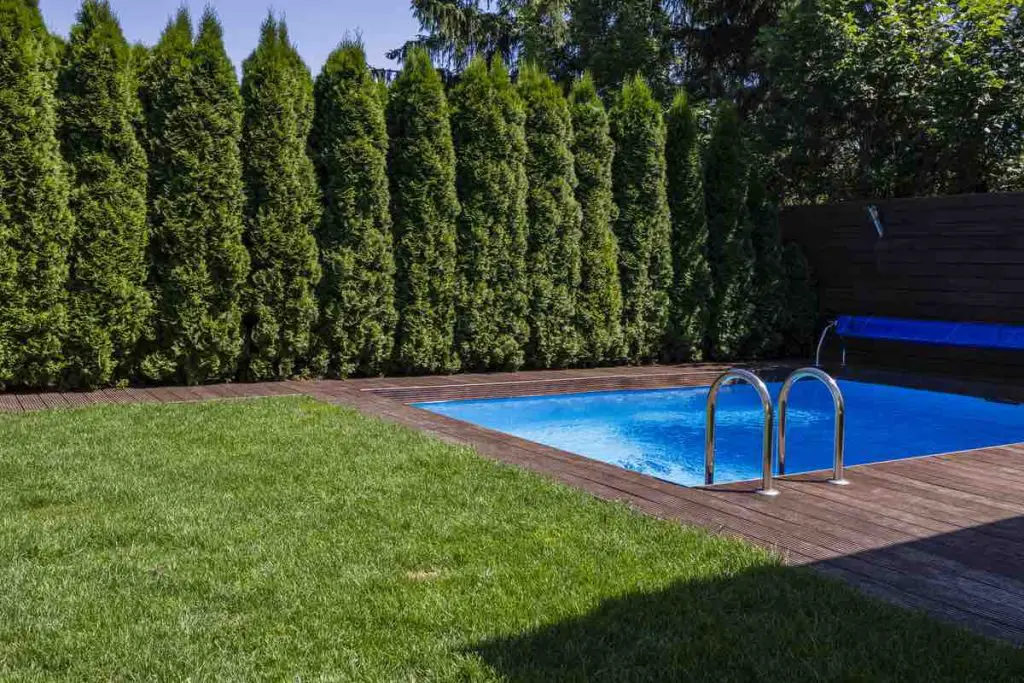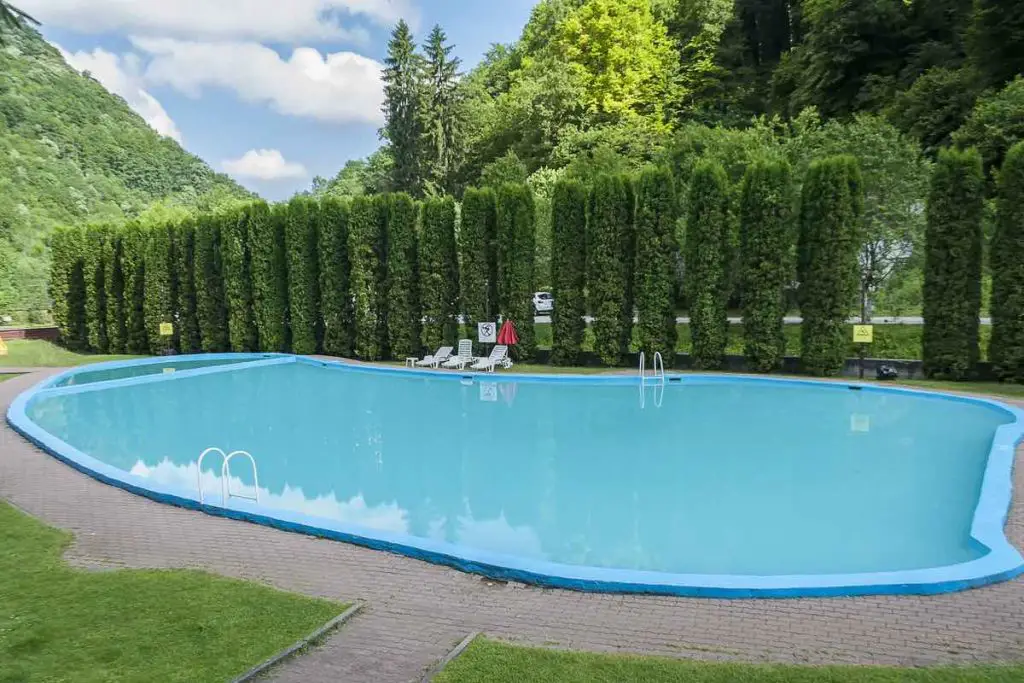Pools can provide some much-needed cooling relief during unbearably hot summers. Proper maintenance is crucial to keeping your pool functional for longer, so you must consider issues such as how tree roots impact swimming pools.
Tree roots can damage swimming pools. Trees with extensive root systems that grow too close to a swimming pool that has not been reinforced with concrete or fiberglass risk damaging the pool’s structure and plumbing. Nonetheless, you can apply a series of measures to fix or avoid this.
The rest of this article will cover how tree roots can damage your swimming pool and what you should do to correct this. We will also look into preventive measures you should apply when constructing a swimming pool near trees and share some other factors that can cause structural damage to your swimming pool.

How Tree Roots Can Damage a Swimming Pool
Planting trees around a pool may seem like a good idea, both for the ambience they create and the cool shade they provide.
They may even seem harmless when planting because their roots are still small. Nonetheless, with time, some invasive trees develop solid and extensive roots that may compromise the structure of your pool, causing cracks, leaks, and damaged plumbing.
Let’s look at how far you should plant trees from swimming pools.
What Distance Should You Keep Between Trees and Swimming Pools?
Experts recommend maintaining a distance of 15 feet (4.57 m) between trees and swimming pools to prevent root damage. When constructing a new swimming pool, ensure that the canopy of the existing trees does not extend over the pool, as it is often a reflection of the root’s spread.
It is important to note that some trees have a non-invasive tap root system, and these do not pose a risk to your swimming pool. Therefore, if you prefer to have trees around your pool for landscaping, consider getting these trees instead.
How To Manage Trees Around Your Swimming Pool
Perhaps there are already some trees around your pool, and you are worried about potential root damage. Are there any steps you can take to manage the trees and correct any damage?
Here are some options:
- Uprooting and replacing invasive trees with non-invasive ones. Undoubtedly, this process will require expertise to keep your landscaping and pool intact. Even so, it is one of your best long-term options.
- Pruning trees with extensive roots. A general rule of thumb is that tree roots only extend as far as the canopy does. Therefore, you may opt for branch and root trimming to prevent the roots from damaging your swimming pool.
- Install root barriers. Root barriers prevent roots from further growing in a particular direction. You can install them before or after planting a tree, and they can help keep your pool safe from damage.
If your swimming pool has already suffered damage from tree roots, the good news is that it can be fixed. Conducting regular inspections and keeping track of any abnormalities will help you catch these issues early enough. Unfortunately, the more damage your pool has, the harder it will get to correct.
How To Prevent Damage to Your Swimming Pool During Construction
During the construction of your swimming pool, these guidelines can help you protect your swimming pool from tree roots:
- Reinforce your pool with concrete or fiberglass. These materials provide a solid perimeter around your swimming pool. Avoid using vinyl, which is not sturdy enough and can succumb to the force of woody roots.
- Move or remove trees with extensive roots. Uproot or relocate invasive trees away from where you plan to construct the swimming pool.
- Install root barriers. Root barriers around problematic and invasive trees keep their roots from extending to your pool and causing damage.
- Keep a safe distance between trees and your swimming pool. If moving or relocating trees is not an option, ensure you keep a safe distance of up to fifteen feet (4.57 m) between trees and the swimming pool.
- Opt for concrete pavers around the pool deck. Concrete pavers are relatively easy to remove and replace when correcting root damage around your pool.
Can Tree Stumps Cause Root Damage in Swimming Pools?
Tree stumps can also compromise your swimming pool’s structure. Because they begin to rot with time, they may leave a void in the ground, which has to be filled by the surrounding earth. When this happens, structures around that area can become compromised.
Additional Factors That Can Cause Structural Damage in Swimming Pools
Tree roots are just one factor that can cause structural damage to swimming pools. Here are some additional issues that you should be on the lookout for:
- Poor engineering: Design flaws, which may result from a lack of expertise/experience, can result in a weak pool structure that quickly gets damaged by tree roots. Always work with an accredited expert.
- Ground movement: Whether from acts of nature such as earthquakes or shifting and settling soil, ground movement can negatively impact the structure of your swimming pool, making it more susceptible to outside forces.
- Poor construction: Using low-quality materials and equipment or poor craftsmanship during construction will cause structural problems, so you should only hire experts and use the best quality materials. Weak borders around your pool can easily be destroyed by tree roots.
- Groundwater pressure: Hydrostatic pressure exerted by groundwater may cause structural damage to drained pools. Therefore, always work with an expert before draining your pool.
- Seasonal weather changes: Temperature fluctuations during hot and cold seasons can expand and contract water and concrete in the swimming pool. Consequently, you may notice cracks in the structure.
- Natural decline: Like any other structure, pools that have been around for many years are subject to structural decline. However, promptly correcting any issues can help slow down the deterioration process.

Conclusion
Tree roots can damage swimming pools that have not been reinforced with concrete or fiberglass by causing cracks and leaks. You can correct this by taking steps such as removing the trees, using root barriers, and pruning the roots and branches.
When constructing a swimming pool, consider factors that compromise its structure, such as quality of materials used, design and engineering procedures, proximity to invasive trees, and prevalence of natural disasters.
Most importantly, always work with an accredited expert, as it can save you a world of trouble.
Sources
- California Pools: Will Tree Roots Affect My Swimming Pools/ Spa?
- The Fiberglass Pool Company: How Will Trees Affect My Pool?
- Kailey Tree Service: 5 Reasons to Remove Trees Near Pools
- Garden Tabs: How Close to a Pool Can You Plant A Tree?
- San Diego Pools: How to Prevent Tree Roots From Damaging Your Pool
- Aquaponics Pools: Common Causes of Pool Leaks and How to Prevent Them
- Team Pool Works: Concrete Pool Repair: Structural Problems
- WTX Foundation Repair: Swimming Pools and Foundation Damage
